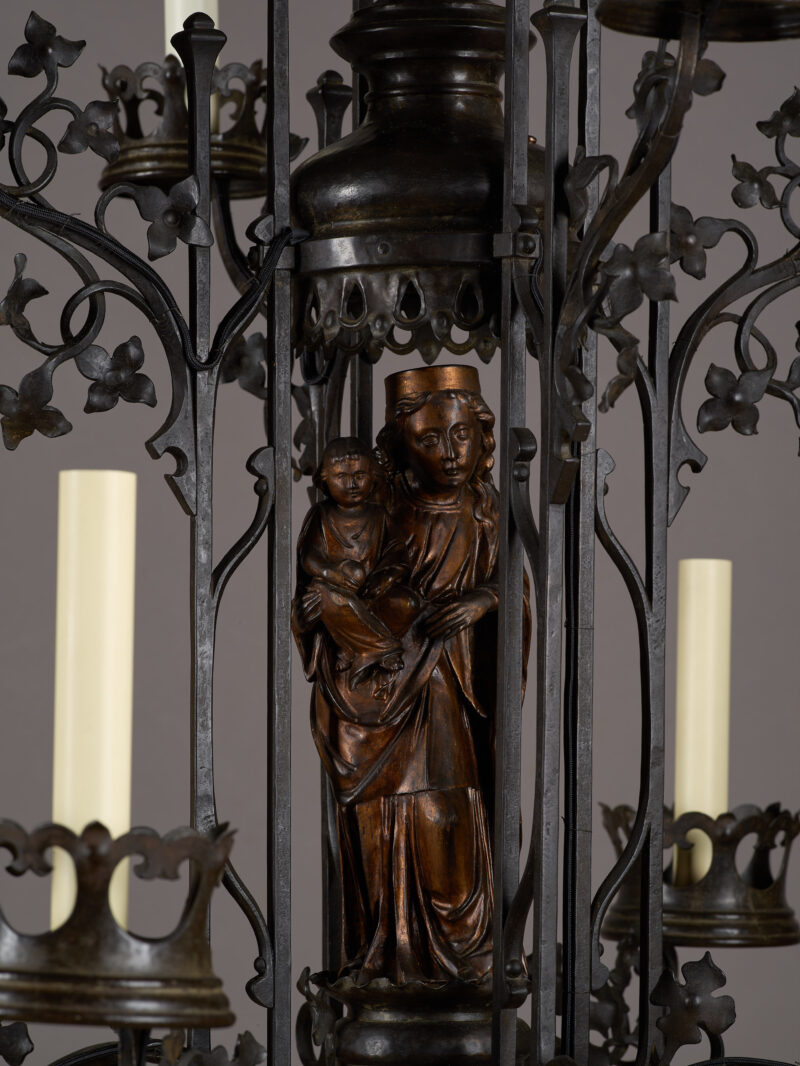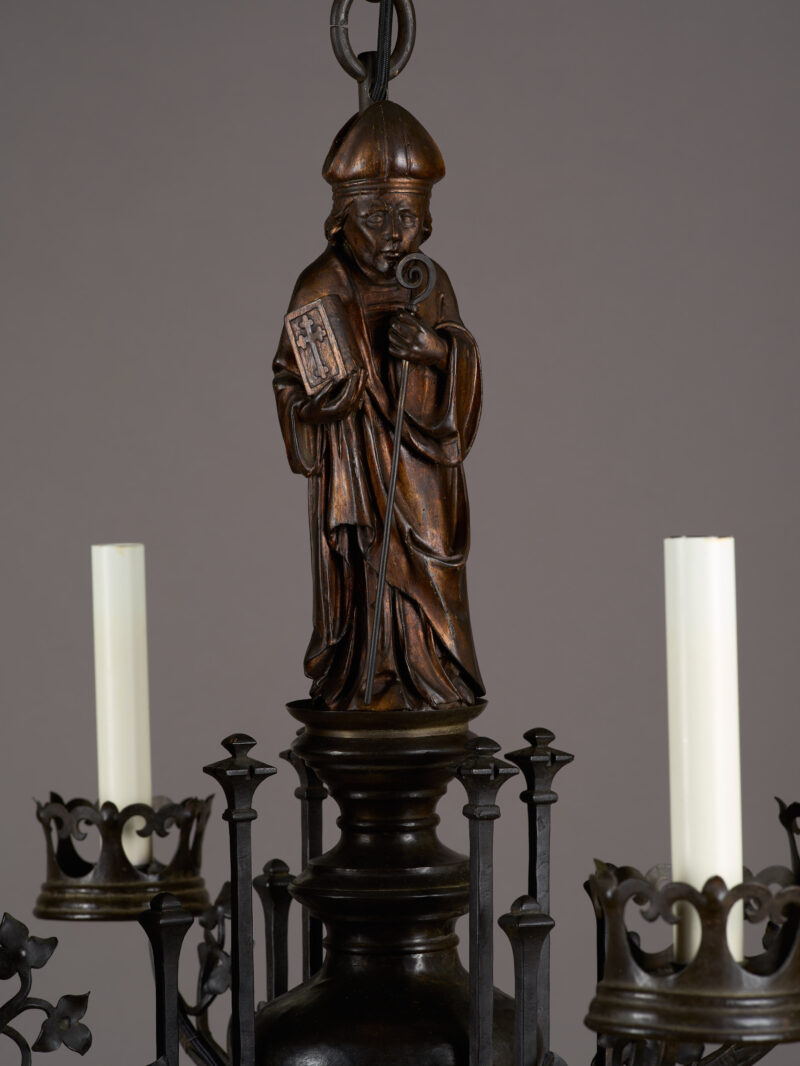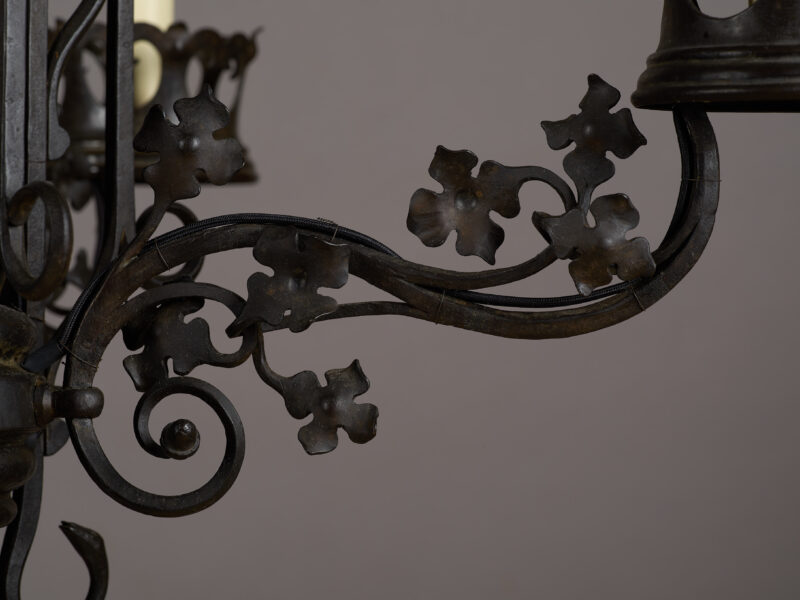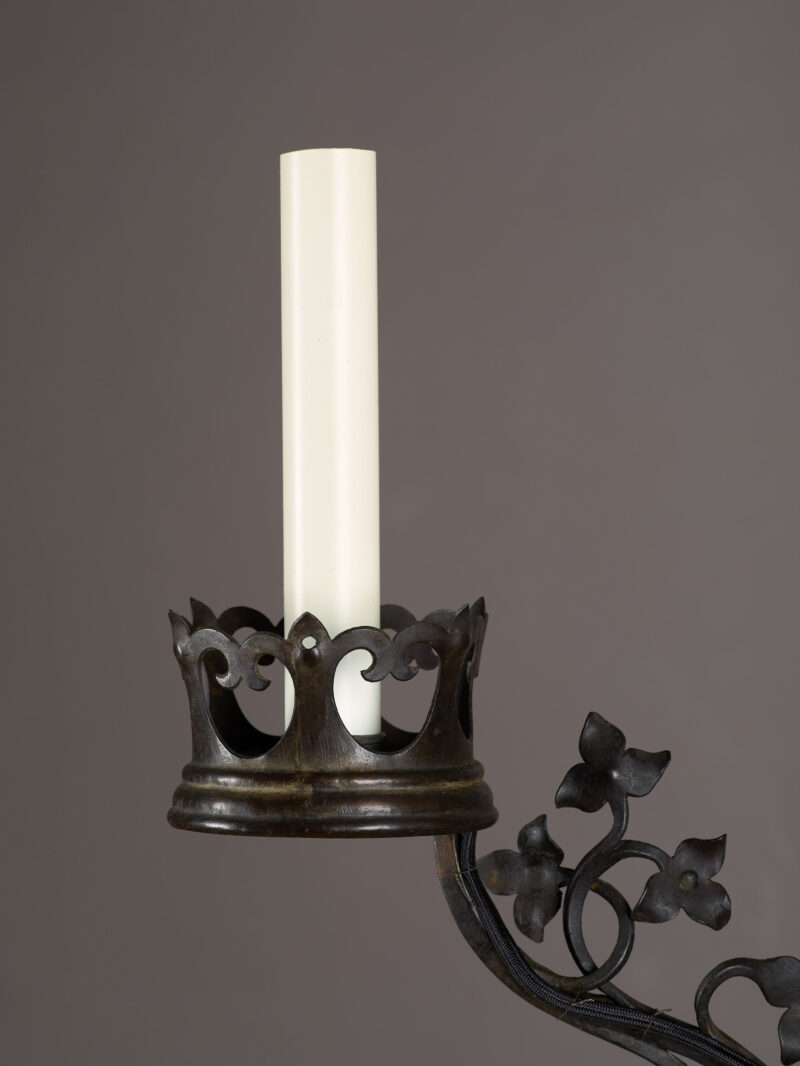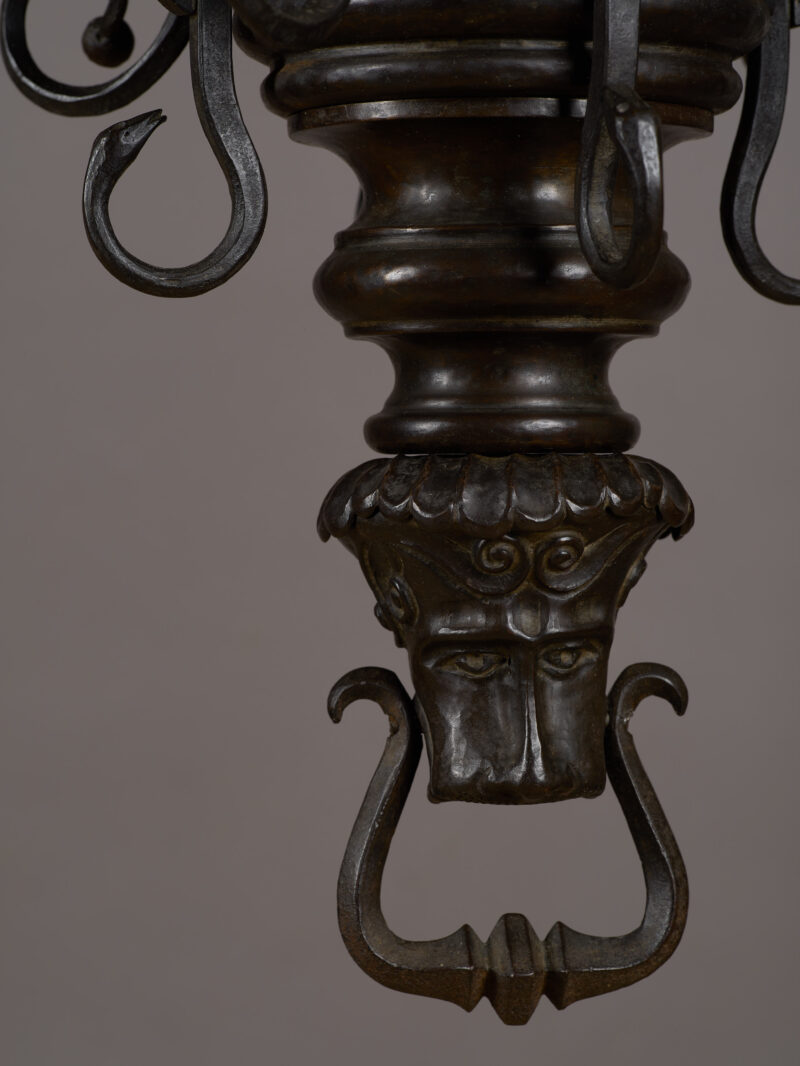
Chapel-Crown from the Goslar Workshop around 1480
A rare and intricately crafted Chapel Crown based on a design inspired by the “Goslar Chapel Crown”, which is currently housed in the Goslar Town Hall. The original chandelier dates back to around 1480 and was created in a workshop in Goslar.
The chapel crown was likely originally intended for the Goslar Cathedral. More details about this can be found below.
Elaborately hand-forged from iron, the chandelier features a chapel-like central structure meticulously adorned with Gothic ornamentation and architectural style in every detail.
Within the open chapel, enclosed by four main pillars embellished with symbolic serpent heads at their ends, and surrounded by crossbeams, stands the fully sculpted figure of Mary with her child.
The wooden-carved and bronzed figure of Mary is adorned with a grand crown, her robe cascading in triple-tiered folds, extending down to the ground with bowl and tubular folds. In her right arm, she carries the clothed infant Jesus, who holds the globe in his right hand.
Surrounding the chapel-like center are a total of eight chandelier arms across two levels, richly adorned with exquisitely wrought cross-shaped foliage. The crown arms, situated both below and above the chapel, are curved in shape and embellished with a fully sculpted acorn, symbolizing the promise of God, as a finishing touch. The intricately designed drip pans are crafted in a crown shape and constitute a dominant element of the chandelier. The lower termination features a fully sculpted lion’s head with stylized mane and a profiled forged, movable handle in its mouth.
The chandelier is crowned by an episcopal figure, fully sculpted in wood and bronzed, featuring a mitre, an episcopal staff in the left hand, and the Book of Rules in the right hand. As the uppermost element, a large forged and ornately adorned ceiling bowl serves as the crowning piece.
An absolutely rare chapel crown, meticulously hand-forged with masterful quality in the 19th century. Chandeliers of this type are generally scarce.
Significant examples, besides the Goslar chandelier, are found in places such as the Augsburg Cathedral, the St. Andrew’s Church in Halberstadt, and the Parish Church in Stans, Switzerland. It’s also worth mentioning the splendidly crafted patinated bronze chandelier from the Nuremberg St. Lorenz Church, designed and executed in 1489 by bronze caster and sculptor Vischer, Peter the Elder, Nuremberg (1460−1529).
Literature: In his 1967 book “Lichter Leuchten im Abendland: Zweitausend Jahre Beleuchtungskörper (Lights Shining in the Occident: Two Thousand Years of Lighting Objects),” Kurt Jarmuth wonderfully describes the history of light bearers, including the origins of the chapel crown. Below is an excerpt from Jarmuth’s book about chapel crowns and their creation, where he also writes about the Goslar crown:
The chapel-crown:
The crown of Stans is one of the most mature specimens of this genus. The characteristic name is given by the chapel-like construction of the middle gives it its name, in which all parts are taken from the building elements and the ornamentation of the great architecture. This is the basics of Gothic craftsmanship, that it did not develop its own motifs, but lived entirely from the repetition of the architectural style. This could be considered a weakness, but from a different point of view it is the sign of strength. The time pressing for direction and movement in all expressions of art had gained its dazzling representation in the high cathedrals.
Growing from the low flight of the houses, they were the focal point of a rising street row or a sharp-angled square. The cityscape of the Gothic trading venues received the appeal of greatness through them. He still captures us today, for example, when we looked at the Flemish cities of Ghent, Bruges or Antwerp (Fig. 64). In their time, other art divisions could not counter anything equivalent to these sublime monuments of architecture. And they didn’t want it either.
It was their task to join the Queen Architecture at her price.
As an example of such a creative interaction, we can consider the image of a silver monstrance (Fig. 65). Their construction runs according to the rule book of great art and yet preserves an individual handwriting. The same was true of the chandeliers, which, according to the same view, created the airy construction of an open chapel as an ornamental casing or tabernacle in which a Mary or a saint was enthroned. The suspension of the crown was connected to this chapel as the central axis. The crown arms, which started below the chapel, received an arch shape made of flat metal and looked with their ornaments as if cut out with the fretsaw, having a technique that will be discussed in more detail in a later paragraph.
The Gothic crowns were the mostly cross-shaped foliage. Sigurd Erixon assumes as an explanation that it is a stylized wine foliage, which together with the figures of saints is based on the biblical parable of the Weinberg should point out. An important style element on the lights is the drop bowl. It has an angular bowl dish with a leaf edge attached to the lower edge. Inverted, the structure would resemble a crown. Erich Meyer notes that the leaf wreath under the shell contracts the tighter the later the crown was created. The attachment of the candles also needs to be mentioned. With the chapel crowns, which were used in churches and town halls, drop shells with thorns to put on the candles can usually be observed.
Candle grommets, on the other hand, are predominant in the genus of shaft crowns that is still to be discussed. An important example of such a chapel crown is located in the Regensburg Town Hall (Fig. 83), a replica hangs in the National Museum in Munich.
In the town hall of Goslar there is a duplicate specimen with figures, the upper figure represents a bishop (Fig. 67). As Günther Griep has noted, this piece comes from a Goslar workshop.
A very rich creation of this type hangs in the Augsburg Cathedral (Fig. 68). It takes up as a motif the idea of letting the mathematically constructed tower of a cathedral grow out of a dense, nature-reinforming bush of the arms. It seems as if it should be depicted how the clear divine thought rises from the frizzy world. It is believed that this crown was made in the area of Dinant.
The artistic performance and pronounced solemnity of the larger Gothic chandelier types, as we get to know them in the chapel crown and in the basket crown discussed below, has so far been too little appreciated in art history. The integration of these luminaires into the arts and crafts and into the field of utility equipment has very wrongly led to a secondary evaluation of their artistic work. With their best pieces, they deserved to be placed close to pure art. The examples from Augsburg and Goslar show how the designers of the luminaires, like the builders of the places of worship, were anxious to point the viewer to a superordinate world. They made use of the delicate architecture of the pillars, ornamental gable and fialen and subordinated themselves externally to great art, as the craftsmen and artists of all disciplines did with this unique expression of their time. But they created a peculiar, thought-filled and artistic image. The central axis of their chandeliers, shaped into a ‘tabernacle, was not only the location of a Mary with the child or a patron saint. The reinforcement to a transcendented appearance of the pious image floating above man led them through the further component available to them, the artificial light. This radiated from the candles that stood around the hanging chapel. The calculated effect of light must not be disregarded in the evaluation of a chandelier, as it may be missing, for example, in the evaluation of stained glass. It is not enough to register only the material forms of a candlestick in art history. First together with the fluidum of the Light can be judged on the success or failure of a work of art that was intended for nothing less than to hover over a congregation or a council meeting as a symbol of the presence of God.
The Goslar Cathedral is the former collegiate church of St. Simon and St. Jude in Goslar. It was built between 1040 and 1050, was a component of the Goslar Imperial Palace district, and was dismantled between 1819 and 1822.
Today, only the northern cathedral vestibule remains.
The term “Dom” here doesn’t carry the modern meaning of “cathedral” but rather the older meaning of “minster.”
